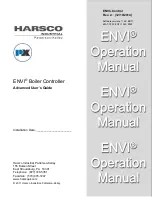
Parameters 257
99.05
Motor ctrl mode
Selects the motor control mode.
DTC
Direct torque control. This mode is suitable for most
applications.
Note:
Instead of direct torque control, use scalar control
• with multimotor applications 1) if the load is not equally
shared between the motors, 2) if the motors are of different
sizes, or 3) if the motors are going to be changed after the
motor identification (ID run),
• if the nominal current of the motor is less than 1/6 of the
nominal output current of the drive,
• if the drive is used with no motor connected (for example,
for test purposes),
• if the drive runs a medium-voltage motor through a step-up
transformer.
0
Scalar
Scalar control. This mode is suitable in special cases where
DTC cannot be applied. In scalar control, the drive is
controlled with a frequency reference. The outstanding motor
control accuracy of DTC cannot be achieved in scalar control.
Some standard features are disabled in scalar control mode.
Note:
Correct motor run requires that the magnetizing current
of the motor does not exceed 90% of the nominal current of
the inverter.
See also section
1
99.06
Mot nom current
Defines the nominal motor current. Must be equal to the value
on the motor rating plate. If multiple motors are connected to
the drive, enter the total current of the motors.
Notes:
• Correct motor run requires that the magnetizing current of
the motor does not exceed 90% of the nominal current of
the drive.
• This parameter cannot be changed while the drive is
running.
0.0 … 6400.0 A
Nominal current of the motor. The allowable range is 1/6…2 ×
I
Hd
of the drive (0…2 ×
I
Hd
with scalar control mode).
10 = 1 A
99.07
Mot nom voltage
Defines the nominal motor voltage as fundamental phase-to-
phase rms voltage supplied to the motor at the nominal
operating point. This setting must match the value on the
rating plate of the motor.
Notes:
• With permanent magnet motors, the nominal voltage is the
BackEMF voltage at nominal speed of the motor. If the
voltage is given as voltage per rpm, e.g. 60 V per 1000
rpm, the voltage for a nominal speed of 3000 rpm is
3 × 60 V = 180 V. Note that the nominal voltage is not
equal to the equivalent DC motor voltage (EDCM)
specified by some motor manufacturers. The nominal
voltage can be calculated by dividing the EDCM voltage by
1.7 (or square root of 3).
• The stress on the motor insulation is always dependent on
the drive supply voltage. This also applies to the case
where the motor voltage rating is lower than that of the
drive and the supply.
• This parameter cannot be changed while the drive is
running.
1/6 … 2 ×
U
N
Nominal voltage of the motor.
10 = 1 V
No.
Name/Value
Description
FbEq
Summary of Contents for ACS850 series
Page 1: ...ACS850 Firmware Manual ACS850 Standard Control Program ...
Page 4: ......
Page 56: ...56 Control locations and operating modes ...
Page 262: ...262 Parameters ...
Page 310: ...310 Fault tracing ...
Page 348: ...348 Control through a fieldbus adapter ...
Page 358: ...358 Drive to drive link ...
















































